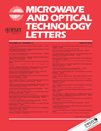Miniaturized coaxial cavity resonator based on anisotropic negative permeability metamaterial loading
Abstract
In this letter, a miniaturized coaxial cylindrical cavity resonator was presented, in which a combination of an ordinary dielectric material and a metamaterial layer has been inserted. First, the general dispersion relation was formulated for such a resonator in three different cases in which the metamaterial layer is: (i) an isotropic μ and ε negative (double negative or DNG) medium; (ii) an isotropic μ negative (MNG) medium; or (iii) an anisotropic MNG (AMNG) medium. Extracting the approximate dispersion relation in the subwavelength scenario, it is shown that this configuration may in principal exhibit an arbitrary low resonant frequency for a fixed dimension, not only in the case of isotropic DNG or isotropic MNG layers but also in the case of a much less complex AMNG layer, which is of importance from the practical realization point of view. In comparison with miniaturized rectangular cavities and also miniaturized one-dimensional resonators, the aforementioned resonator provides the possibility of selecting a distinct mode and also provides a further degree of freedom in the approximate dispersion relation, which brings more flexibility in designing miniaturized resonators. As an example, design and simulation of a miniaturized coaxial cavity resonator together with the complete design of the AMNG layer are presented. The resultant cavity diameter is shortened by ∼ 60% in comparison with theoretical minimum dimensions of a cylindrical cavity resonator of the same height. Finally, the designed cavity has been fabricated and tested. The measured and simulated responses are in close agreement with each other. © 2012 Wiley Periodicals, Inc. Microwave Opt Technol Lett 54:595–599, 2012; View this article online at wileyonlinelibrary.com. DOI 10.1002/mop.26600




